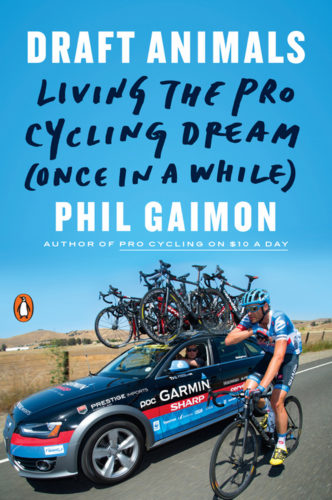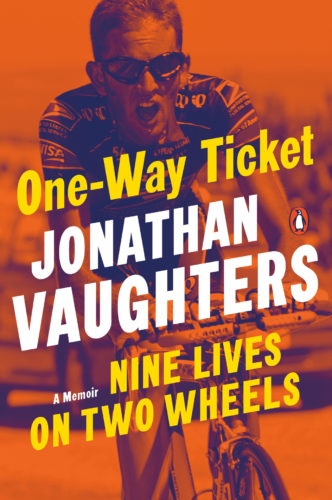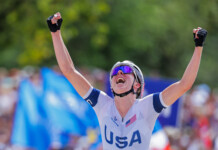By Don Scheese —
Draft Animals: Living the Pro Cycling Dream (Once in a While) by Phil Gaimon. New York: Penguin, 2017. 320 pp. $17.00 paperback.One-Way Ticket: Nine Lives on Two Wheels by Jonathan Vaughters. New York: Penguin, 2019. 339 pp. $17.00 paperback.
If, like me, you follow pro cycling and are a fan of EF Education First (as well as its previous iterations), maybe even proudly wear some or all of the team’s kit, then these books are for you. Jonathan Vaughters rode professionally in the 1990s and 2000s, including a stint with U.S. Postal and Lance Armstrong, was a decent rider in his own right (once setting the record for the time trial up Mont Ventoux), then gradually fell out of the sport after witnessing and participating in the epidemic of EPO usage in the peloton. Feeling morally compromised, but still in love with cycling, he then decided to try to organize and run a “clean” team, originally called Slipstream. Vaughters went on to play a key role in bringing down Armstrong in 2012 as part of the damning testimony for the United States Anti-Doping Agency (USADA) investigation, rocking the cycling and sporting worlds.
 Phil Gaimon was one of the many young new beneficiaries of Vaughters’ and others’ efforts in helping to clean up the sport. Riding in what he refers to as the “post-dopacalypse” (3) era following Armstrong’s downfall, Gaimon achieved some impressive results at the Pro-Continental level (including winning the Redlands Classic) before being signed by Vaughters to race in 2014 and 2015. However, in the wake of Armstrong’s demise, money was much harder to come by as sponsorship dollars dried up, teams folded, and the competition for fewer spots on teams grew ever tighter. Gaimon rode for Vaughters for only two years and has some very unkind—though seemingly justified—criticisms of his former employer.
Phil Gaimon was one of the many young new beneficiaries of Vaughters’ and others’ efforts in helping to clean up the sport. Riding in what he refers to as the “post-dopacalypse” (3) era following Armstrong’s downfall, Gaimon achieved some impressive results at the Pro-Continental level (including winning the Redlands Classic) before being signed by Vaughters to race in 2014 and 2015. However, in the wake of Armstrong’s demise, money was much harder to come by as sponsorship dollars dried up, teams folded, and the competition for fewer spots on teams grew ever tighter. Gaimon rode for Vaughters for only two years and has some very unkind—though seemingly justified—criticisms of his former employer.
Let’s start with the better of the two books (more on that later). Gaimon was an outspoken critic of doping, proudly sporting his “CLEAN” tattoo and regularly lamenting on the internet and social media the financial doldrums into which professional cycling plunged in his era. As a rider in the World Tour Gaimon mainly rode as a domestique, with crashes, illness, bad luck and (at times) his own self-described stupidity preventing him from achieving more impressive results. In fact, one of the main themes of his book is the realization that “everyone’s not a winner” (200). Many (most?) of us don’t realize our greatest dreams and have to settle for a less impressive victory or goal. Gaining more experience in the pro peloton for Vaughters’ team, Gaimon recognizes what he calls “Real Talent”—teammates like Dan Martin and Michael Woods, for example, riders whose VO2 max is just a bit higher and whose results are thus just more impressive. One of the more interesting—let’s say juicier—aspects of his book is the differentiation Gaimon makes between not only Real and Mediocre Talents, but between Good Guys and Bad Guys. Martin and Woods, along with other teammates like Andrew Talansky, Tyler Farrar, and Alex Howes, clearly are Good Guys, while Andy and Frank Schleck, Fabian Cancellara, David Millar, Rohan Dennis, and Chris Horner definitely fall into the Bad Guy category (you have to read the book to find out why).
More challenging for Gaimon to classify are former dopers like Tom Danielson and Thomas Dekker. He wants to dislike and dismiss riders like these from the EPO era, but upon becoming teammates and experiencing them as Real People finds it hard to do so. Each guy proves to be a good teammate, especially Danielson, who trains with and helps Gaimon keep the yellow jersey after Gaimon wins the first stage of his very first World Tour race, the Tour de San Luis in Colombia (finishing second overall by the end). And some of the book’s funniest moments involve Dekker, whom Gaimon finds “warm and inviting…. [someone who ] always said the right thing.” “He’d been a bad boy,” says Gaimon, “but he seemed like a good man” (113). Even when Dekker, the shell of a racer he once was when on EPO and living a lavish lifestyle, meets and falls in love with a woman from LA who happens to be a billionaire, Gaimon, relationship-challenged though he may have been, never expresses jealousy, only a plaintive “if only that were me” kind of lament. (Warning to all prospective pro cyclists: a theme in both books is how hard the cycling life is on relationships with the opposite sex.)
Draft Animals reminded me a lot of Ball Four as I was reading it, Jim Bouton’s pathbreaking “tell-all” memoir published in the 1960s that sent tectonic shivers through the baseball, and sportswriting, worlds. Like Bouton, Gaimon provides an insider’s view of a sport, with titillating anecdotes about the sexual lives of pro athletes, the outlandish pranks of jocks, and the Machiavellian tactics of team owners during contract negotiations. Here’s where Jonathan Vaughters, as co-founder, sports director (at times), and CEO of Slipstream clearly comes across as another Bad Guy. If Gaimon can be believed (and I have no reason not to think this is a totally honest memoir), “JV” (as Vaughters is called) not only lowballs Gaimon in negotiations, he reneges on dollar figures once offered and leaves Gaimon (as well as other riders) hanging for an unconscionable length of time near season’s end when diminishing slots on rival teams are fast disappearing. And when Gaimon finally comes to the end of the 2016 season without a contract, all he gets from Vaughters’ team is a form letter from an assistant stating his services would no longer be needed. Gaimon bitterly concludes: “Vaughters is an evil hypocrite” and doubts that “JV has any real friends [because] he only goes out of his way when something’s in it for him” (311).
I’m probably prejudiced because I read Gaimon’s book first, and thus my impressions of Vaughters were already formed before I even picked up his book. But even after reading One-Way Ticket and getting JV’s point of view, I find it hard to like him or his book. As I was reading Vaughters’ memoir I kept wondering, had he read Gaimon’s book? Tellingly, Vaughters never mentions Gaimon, not once. I suppose this could be justified in the sense that Gaimon was a “lesser” talent and rider on his team, during a decade or so during which he signed and managed many riders. But as someone who perhaps more than any other young rider in the post-Lance era personified the “Riding Clean” credo and gave cycling fans hope for a doping-free sport, one would think that Gaimon would have been the Perfect Spokesperson for Vaughters.
 Even more telling is another omission: the failure to mention Tom Danielson’s bust for testosterone usage during the Tour of Utah in 2016. Vaughters had once promised to dissolve his team if any rider of his had had a positive test, and surely readers would have loved to know what went through his mind upon learning of Danielson’s banishment. Obviously the team did not dissolve, and we are left wondering why not.
Even more telling is another omission: the failure to mention Tom Danielson’s bust for testosterone usage during the Tour of Utah in 2016. Vaughters had once promised to dissolve his team if any rider of his had had a positive test, and surely readers would have loved to know what went through his mind upon learning of Danielson’s banishment. Obviously the team did not dissolve, and we are left wondering why not.
Vaughters deserves respect, though, for his determination, his smarts, his courage in taking on Armstrong, and his ingenuity and business acumen in promoting a “clean team” at the very moment the sport needed it most. As a skinny, anti-social, nerdy kid growing up in Denver frequently bullied and ostracized for getting involved in a fringe sport, Vaughters tells of finishing dead last in his very first race, only to come back and win the Mt. Evans race a couple years later as a junior cyclist. He goes on to become the #1 rider in Colorado, and makes the US National team competing against Armstrong and George Hincapie. He then gains his first pro contract with a Spanish team, where in his initial race he finishes last again (this time with a Belgian rider named Johan Bruyneel). It was in Europe, of course, where he would be introduced to the world of doping, quickly learning that in order to keep up with the new EPO generation he would be forced to make a tough moral choice. As in other cycling memoirs by former dopers such as David Millar (see his Racing Through the Dark), the decision to dope or not involves a gradual descent down a slippery slope. First comes injectable vitamins and “recovery drugs,” then testosterone and human growth hormone, followed by the real performance-booster, EPO, which could result in as much as a 10% gain in performance. In the 1990s and early 2000s, a naïve young American rider comes to realize that “EPO was the only way to succeed, even survive” (131), ultimately leading him to conclude, “Doping suddenly seemed like the right choice” (152).
Once on US Postal, Vaughters witnesses first hand Armstrong injecting EPO, and feels like he has no choice, if he wants to remain on the team, of following suit. But after winning the time trial up Mont Ventoux in the 1999 Tour de France, he sees his achievement as a hollow victory, even “a joke” (185). He becomes increasingly apprehensive about getting caught, especially after the governing body of the sport, the UCI, develops a test for EPO, and is horrified and terrified when his urine turns purple after being injected with various PEDs. But he continues to use EPO, off and on, until 2002, when riding for a French team, he suddenly quits with two years left on his contract. This gutsy decision ultimately would lead to his founding of a new kind of cycling team.
Vaughters had always been fascinated with the math and physics of cycling, and claims to be one of the earliest pros to use a power meter and interval training in his workouts. Always the analytical type, he figures out that often a race will come down to certain “power moments,” minutes when the winner can generate an extraordinary amount of watts at a crucial moment to take the victory. It was this kind of thinking that helped convince a deep pockets cycling fan, Doug Ellis, to initially fund team Slipstream, convincing Ellis that “maybe clean cycling was a better business model” (230) in the post-Lance era. Another crucial realization of his was that to start a clean team after two decades of EPO use meant that to be competitive, one had no choice but to sign former dopers such as David Millar and Thomas Dekker (but not Floyd Landis, about whom Vaughters says was more concerned with revenge on the sport than winning performances). Their confessions gave authorities insight into the culture of doping as well as the riders a chance to redeem themselves. .And Vaughters deserves much credit, not only for starting a team committed to clean cycling, but also for his courage to speak out about doping. He anonymously confirmed Frankie Andreu’s confession about doping on the US Postal team in 2010, then came out in defense of Landis after the aggrieved rider publicly revealed his and Postal’s doping the same year. And of course Vaughters eventually became a key witness in the USADA investigation into Armstrong and the epidemic of doping in the sport.
Vaughters presents his Good Guys and Bad Guys too, and clearly falling into the latter category are Bradley Wiggins and Dave Brailsford, team director of Team Sky (now INEOS). If JV can be believed, Wiggins, whom he recognized before anyone else as a track cyclist who could be successfully converted into a Tour de France contender, essentially abandoned Garmin after coming in fourth in the 2009 Tour because he was constantly wooed by Brailsford representing a new British entity in the peloton, even though he had years remaining on his contract. (JV also accused Armstrong, in an act of revenge against him, of helping to convince Wiggins that he’d be much better off on Sky.) I found this section of the book to be one of most fascinating sections of One-Way Ticket.
The final chapters deal with Vaughters’ desperate attempts to save the team following the pull outs of principle sponsors Cervelo then Cannondale. At one point he even resorted, in a last ditch attempt to save the franchise, to starting a crowdfunding campaign (“#SaveArgyle”) to keep the team afloat for another year. But in stepped EF Education First to save the day, though it meant that long-time owner Ellis would have to agree to sell the team to this new organization.
As I’ve made clear, Draft Animals is by far the better book. Here’s why: Gaimon was an English major in college who took creative writing classes, and it shows. His writing style is fluent and polished, and the book is laugh-out-loud funny throughout. (This is his third book:
the first was Pro Cycling on $10 a Day, published in 20I4; the second Ask a Pro, 2017.) In contrast, Vaughters’ style is wooden, his frequent pop-culture allusions are ineffective and annoying, and his attempts at humor mostly fall flat. In the contest of personalities Gaimon is the clear winner (how do you not like a guy who gives his excess cookies to the homeless?)
Reading these books caused me to reflect on the state of pro cycling today. On the one hand, with the advent of the biological passport and more professional testing by the UCI, the sport seems cleaner than ever. But then four-time winner of the Tour, two-timer winner of the Vuelta, and one-time winner of the Giro Chris Froome of Team Sky registers an excessive level of an asthma drug following his second Vuelta victory, and once again—no matter how many doctors, medical studies and euros Sky throws at the findings to convince the UCI he didn’t do anything wrong—the sport is enveloped in a cloud of doubt following the bust of one of its biggest names. And then we have NBC Sports featuring as Tour commentators ex-dopers such as Christian Vandevelde and Chris Horner—as well as inviting none other than Lance Armstrong himself for occasional guest commentary! I don’t know about you, but I’m a bit confused, and still suspicious, about the state of cycling’s cleanliness in the year 2019.
Still, Vaughters and Gaimon deserve lots of credit for their efforts to transform the sport, and there is no doubt that cycling is cleaner as a result. Read these books to find out why.
Don Scheese is an avid cyclist and retired professor of American Studies who once taught, among other things, courses on Lance Armstrong and Sport in American Culture.









Interesting article. It appears that the money involved at the pro-level of road racing is just to great to prevent many from finding ways to enhance their performance through chemistry. i.e., asthma drugs or other substances for the extra 1/2 of 1 percent performance boost. Wish it were not so but one still doubts. Does that mean the entire sport would be better off if there were no restrictions and the best chemist won? Hmmmmm.
Comments are closed.